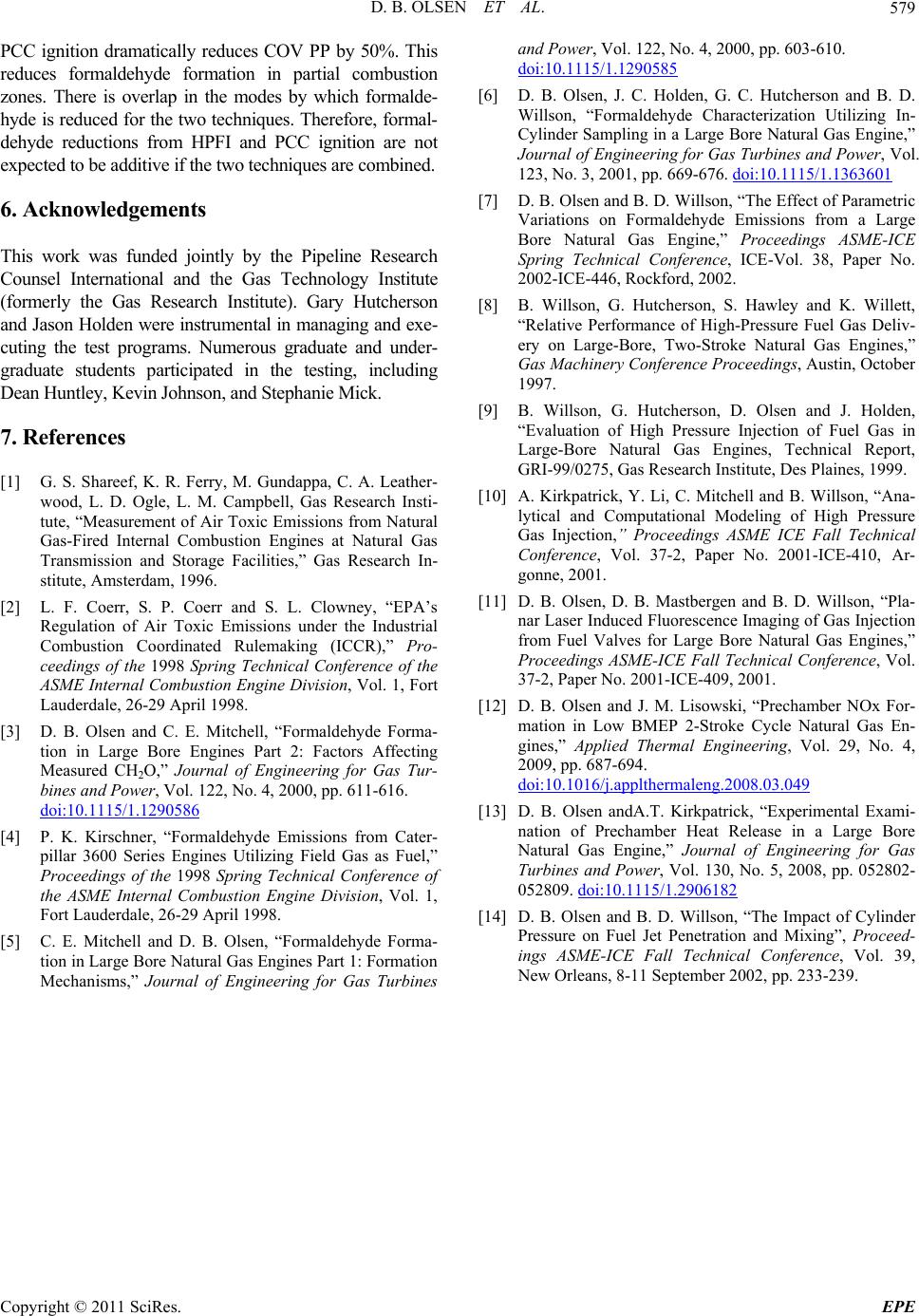
D. B. OLSEN ET AL.
Copyright © 2011 SciRes. EPE
579
PCC ignition dramatically reduces COV PP by 50%. This
reduces formaldehyde formation in partial combustion
zones. There is overlap in the modes by which formalde-
hyde is reduced for the two techniques. Therefore, formal-
dehyde reductions from HPFI and PCC ignition are not
expected to be additive i f the two techniques are com bined.
6. Acknowledgements
This work was funded jointly by the Pipeline Research
Counsel International and the Gas Technology Institute
(formerly the Gas Research Institute). Gary Hutcherson
and Jason Holden were instrumental in managing and exe-
cuting the test programs. Numerous graduate and under-
graduate students participated in the testing, including
Dean Huntley, Kevin Johnson, and Stephanie Mick.
7. References
[1] G. S. Shareef, K. R. Ferry, M. Gundappa, C. A. Leather-
wood, L. D. Ogle, L. M. Campbell, Gas Research Insti-
tute, “Measurement of Air Toxic Emissions from Natural
Gas-Fired Internal Combustion Engines at Natural Gas
Transmission and Storage Facilities,” Gas Research In-
stitute, Amsterdam, 1996.
[2] L. F. Coerr, S. P. Coerr and S. L. Clowney, “EPA’s
Regulation of Air Toxic Emissions under the Industrial
Combustion Coordinated Rulemaking (ICCR),” Pro-
ceedings of the 1998 Spring Technical Conference of the
ASME Internal Combustion Engine Division, Vol. 1, Fort
Lauderdale, 26-29 April 1998.
[3] D. B. Olsen and C. E. Mitchell, “Formaldehyde Forma-
tion in Large Bore Engines Part 2: Factors Affecting
Measured CH2O,” Journal of Engineering for Gas Tur-
bines and Power, Vol. 122, No. 4, 2000, pp. 611-616.
doi:10.1115/1.1290586
[4] P. K. Kirschner, “Formaldehyde Emissions from Cater-
pillar 3600 Series Engines Utilizing Field Gas as Fuel,”
Proceedings of the 1998 Spring Technical Conference of
the ASME Internal Combustion Engine Division, Vol. 1,
Fort Lauderdale, 26-29 April 1998.
[5] C. E. Mitchell and D. B. Olsen, “Formaldehyde Forma-
tion in Large Bore Natural Gas Engines Part 1: Formation
Mechanisms,” Journal of Engineering for Gas Turbines
and Power, Vol. 122, No. 4, 2000, pp. 603-610.
doi:10.1115/1.1290585
[6] D. B. Olsen, J. C. Holden, G. C. Hutcherson and B. D.
Willson, “Formaldehyde Characterization Utilizing In-
Cylinder Sampling in a Large Bore Natural Gas Engine,”
Journal of Engineering for Gas Turbines and Power, Vol.
123, No. 3, 2001, pp. 669-676. doi:10.1115/1.1363601
[7] D. B. Olsen and B. D. Willson, “The Effect of Parametric
Variations on Formaldehyde Emissions from a Large
Bore Natural Gas Engine,” Proceedings ASME-ICE
Spring Technical Conference, ICE-Vol. 38, Paper No.
2002-ICE-446, Rockford, 2 0 02 .
[8] B. Willson, G. Hutcherson, S. Hawley and K. Willett,
“Relative Performance of High-Pressure Fuel Gas Deliv-
ery on Large-Bore, Two-Stroke Natural Gas Engines,”
Gas Machinery Conference Proceedings, Austin, October
1997.
[9] B. Willson, G. Hutcherson, D. Olsen and J. Holden,
“Evaluation of High Pressure Injection of Fuel Gas in
Large-Bore Natural Gas Engines, Technical Report,
GRI-99/0275, Gas Research Institute, Des Plaines, 1999.
[10] A. Kirkpatrick, Y. Li, C. Mitchell and B. Willson, “Ana-
lytical and Computational Modeling of High Pressure
Gas Injection,” Proceedings ASME ICE Fall Technical
Conference, Vol. 37-2, Paper No. 2001-ICE-410, Ar-
gonne, 2001.
[11] D. B. Olsen, D. B. Mastbergen and B. D. Willson, “Pla-
nar Laser Induced Fluorescence Imaging of Gas Injection
from Fuel Valves for Large Bore Natural Gas Engines,”
Proceedings ASME-ICE Fall Technical Conference, Vol.
37-2, Paper No. 2001-ICE-409, 2001.
[12] D. B. Olsen and J. M. Lisowski, “Prechamber NOx For-
mation in Low BMEP 2-Stroke Cycle Natural Gas En-
gines,” Applied Thermal Engineering, Vol. 29, No. 4,
2009, pp. 687-694.
doi:10.1016/j.applthermaleng.2008.03.049
[13] D. B. Olsen andA.T. Kirkpatrick, “Experimental Exami-
nation of Prechamber Heat Release in a Large Bore
Natural Gas Engine,” Journal of Engineering for Gas
Turbines and Power, Vol. 130, No. 5, 2008, pp. 052802-
052809. doi:10.1115/1.2906182
[14] D. B. Olsen and B. D. Willson, “The Impact of Cylinder
Pressure on Fuel Jet Penetration and Mixing”, Proceed-
ings ASME-ICE Fall Technical Conference, Vol. 39,
New Orleans, 8-11 September 2002, pp. 233-239.